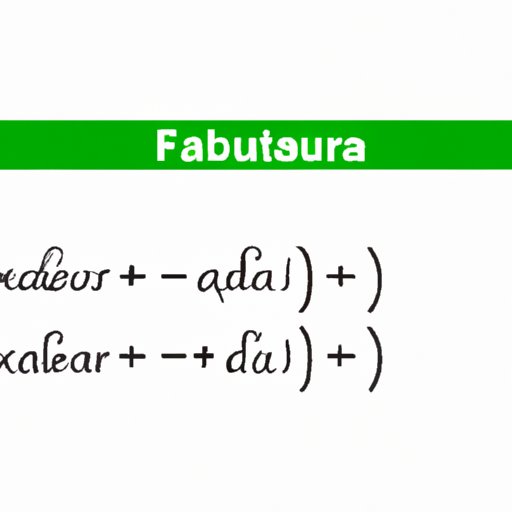Introduction
Mathematics can be a daunting subject for many people, especially when it comes to algebraic equations. However, understanding the basics of algebra is key to mastering more complex mathematical problems. In this article, we’ll explore how to factor quadratic equations, specifically x2 + 9x + 8. We’ll begin by discussing the importance of factoring in algebra and provide a brief overview of what factoring is.
The Importance of Factoring in Algebra
Factoring is an essential skill in algebra that involves breaking down an equation into its individual factors. This skill is important because it allows us to simplify complex equations, making them easier to solve. Factoring can also help identify common factors or patterns in equations, which can simplify future equations and save time.
For example, if we have the equation 4x2 + 20x, we can factor out a common factor of 4x, simplifying the equation to 4x(x + 5). This makes it easier to solve for x because we have reduced the complexity of the equation.
Additionally, factoring is a fundamental skill in algebra. Understanding how to factor equations is crucial in solving a wide range of mathematical problems, from basic algebra problems to more complex calculus problems.
Understanding Quadratic Equations
A quadratic equation is an equation of the form ax2 + bx + c, where a, b, and c are coefficients and x is a variable. These equations often appear in algebra and are frequently used to model real-world problems.
The roots of a quadratic equation are the solutions that make the equation true. We can find the roots of a quadratic equation using the quadratic formula or by factoring the equation.
It’s important to note that there are different forms of quadratic equations, such as vertex form and standard form. However, we’ll focus on standard form since it’s the most commonly used form in algebra.
How to Find the Roots of x2 + 9x + 8 using Factorization
To find the roots of a quadratic equation using factorization, we need to first factor the equation into two sets of parentheses. We can then set each set of parentheses equal to zero and solve for x, giving us the roots of the equation.
Let’s use x2 + 9x + 8 as an example:
x2 + 9x + 8 = (x + )(x + )
To factor this equation, we need to find two numbers that multiply to 8 and add up to 9. These numbers are 1 and 8, so we can write:
x2 + 9x + 8 = (x + 1)(x + 8)
Now that we have factored the equation, we can set each set of parentheses equal to zero:
(x + 1) = 0 or (x + 8) = 0
Solving for x gives us the roots of the equation:
x = -1 or x = -8
Therefore, the roots of x2 + 9x + 8 are -1 and -8.
Solving Quadratic Equations without the Quadratic Formula: A Look at x2 + 9x + 8
The quadratic formula is a method for finding the roots of a quadratic equation. However, it can be tedious and time-consuming for complex equations. Fortunately, there are alternative methods for solving quadratic equations, such as factoring.
Using factoring to solve quadratic equations can be more efficient than using the quadratic formula, especially when the equation is relatively simple. Let’s take a closer look at solving x2 + 9x + 8 using factoring:
x2 + 9x + 8 = (x + 1)(x + 8)
Now that we have factored this equation, we can set each set of parentheses equal to zero:
(x + 1) = 0 or (x + 8) = 0
Solving for x gives us:
x = -1 or x = -8
Therefore, the roots of x2 + 9x + 8 are -1 and -8. This method is simpler and more straightforward than using the quadratic formula.
Examining the Relationship between Quadratic Equations and Factoring: An Analysis of x2 + 9x + 8
There is a strong relationship between quadratic equations and factoring. In fact, factoring is often used to solve quadratic equations. When we factor a quadratic equation, we are essentially breaking it down into its individual components, making it easier to solve for x.
Let’s take another look at x2 + 9x + 8. To solve this equation using the quadratic formula, we would have to plug in values for a, b, and c, then solve for x using the formula.
However, by factoring the equation, we can easily find the roots without having to use the quadratic formula. This shows how factoring can be an efficient and beneficial method for solving quadratic equations.
A Step-by-Step Guide to Factoring the Quadratic Equation x2 + 9x + 8
Now that we’ve covered the basics of factoring and quadratic equations, let’s take a closer look at how to factor x2 + 9x + 8 using the steps outlined in the previous sections.
- Write out the equation in standard form: x2 + 9x + 8
- Find two numbers that multiply to 8 and add up to 9. These numbers are 1 and 8.
- Write out the equation with the two numbers factored in: (x + 1)(x + 8)
- Set each set of parentheses equal to zero and solve for x: x + 1 = 0 or x + 8 = 0, giving us the roots -1 and -8.
By following these steps, we can quickly and efficiently factor quadratic equations like x2 + 9x + 8.
Conclusion
Factoring quadratic equations is an important skill in algebra that allows us to simplify complex equations, identify patterns, and solve for x. Understanding quadratic equations and their relationship to factoring is crucial for solving a wide range of mathematical problems. By learning to factor quadratic equations like x2 + 9x + 8, we can build a stronger foundation in algebra and mathematics as a whole.
